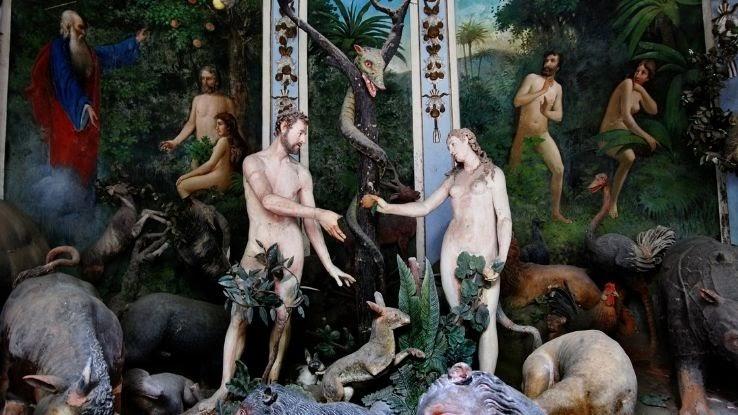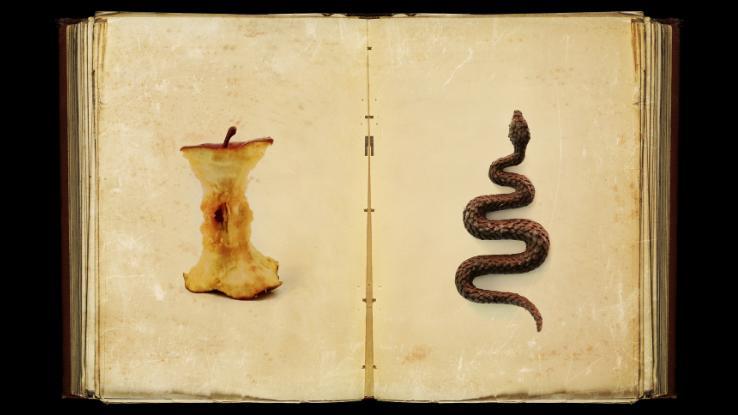He Was Delivered for Our Sins and Was Raised Again for Our Justification

Envy, lust, greed, wrath, sloth, gluttony, and pride are normally referred to as the seven deadly sins. But, what you lot might not know, is that they don't actually originate from the Bible. In fact, they were created thousands of years ago by Evagrius Ponticus, a Greek monk. Ane of his students later introduced them to the Christian church, which, in plow, spread our now-traditional view of the sins — equally well as the notion that committing one of these sins would result in the decease of one'due south soul.
7 Deadly Sins Meanings
Here, we'll explore each of the seven deadly sins in more detail past unpacking their meaning and origins as well as instances of them in folklore, pop culture, and other stories.

Envy | Symbolism & Meaning
Envy involves wanting, or appetent, something others have — and that you don't. Often, dogs and snakes are associated with green-eyed, equally is the colour green, hence the popular phrase "you lot're and then green with green-eyed."
One of the nigh well-known stories revolving around green-eyed is that of Cain and Abel. In the tale, one brother was loved, while the other was disregarded. The overlooked brother became envious of the other one'southward success and ended upward killing his sibling.
Lust | Symbolism & Meaning
When you're overwhelmed with want, you lot're experiencing the sin of lust. The animals associated with lust include cows or snakes, while blueish is ofttimes the colour fastened to the sin — namely because folks are said to experience melancholy in the backwash of lust.
The theme of lust can be plant but about anywhere — in fact, a character's curiosity tin can often lead to lust. In some interpretations of the biblical tale of Adam and Eve, the forbidden fruit is seen as a symbol of animalism.
Greed | Symbolism & Meaning
Similar to envy, the sin of greed is all about desiring what you don't accept. Still, the master difference is that those who are greedy actually get those things, and, equally a outcome, Greed is unremarkably associated with materialism and selfishness. The unofficial symbol for greed? The frog. The colour most often fastened to greed is yellow due to its similarity to gold.
Greed is a pop theme in folk stories. You might call back the story of Rumpelstiltskin, in which a greedy male monarch keeps the miller's daughter locked up and then he tin can accumulate more and more than aureate. Additionally, the Brothers Grimm frequently explored the theme of greed and how information technology affected people's lives. In more contemporary stories, Scrooge McDuck and The Simpsons' Mr. Burns are also caricatures of greed.
Wrath | Symbolism & Meaning
Uncontrolled acrimony leads to wrath, an intense emotion that can lead to violence. The symbol for wrath is the bear, while the color associated with it is cherry. Unsurprisingly, both the bear and the color red stand for passion, aggression and anger.
Homer's Iliad provides a perfect example of wrath in literature. Achilles' fury leads to horrible events, and, by the cease, he realizes what he's done and is filled with terrible regret. Although Achilles idea he was doing the right thing at the time, he later on realized just how many people he hurt through his wrath.
Sloth | Symbolism & Pregnant
Sloth is ordinarily associated with doing goose egg, just information technology can likewise go mitt-in-hand with procrastination. That is, being intentionally unproductive, instead of doing things that are good for you, is considered a sin past some believers. You'd look the brute symbol for the sin of sloth to be, well, the sloth, right? It's actually the goat. Moreover, the color associated with sloth is light blue, which represents daydreaming.
Lazy Heinz is a popular folk tale by the Brothers Grimm that tells the story of a lazy boy who never wanted to do anything and, of course, never accomplished annihilation. Moreover, laziness is commonly portrayed in pop culture equally an unattractive characteristic.
Gluttony | Symbolism & Significant
When you overindulge, you're experiencing the sin of gluttony. Gluttony can also refer to acquiring too many material possessions or pleasurable things. The animal nearly often associated with gluttony is the squealer, while the sin's colour is orange. (Interestingly, you can ofttimes find shades of orange in fast nutrient restaurants equally information technology'due south believed to stimulate your appetite — a potential source of gluttony.)
Gluttony is a common theme in many fairy tales, including Jack and the Beanstalk. Remember the hungry behemothic? He represents gluttony. The Hansel and Gretel story is some other example of gluttony: the titular kids simply can't stop eating a house made of candy. Of class, it turns out that the homeowner is a witch, who, in turn, wants to eat the kids to show them that their gluttonous actions have major consequences.
Pride | Symbolism & Meaning
The sin of pride is associated with big egos and high opinions of one's self. People who exhibit an unhealthy amount of pride are often unable to exhibit self-sensation. Symbols associated with pride include the equus caballus, lion, and peacock. Moreover, the sin is represented by the color purple — historically, the hue of royalty.
One of the nigh well-known Biblical stories of pride centers on the angel Lucifer, who was supposedly overly concerned with his beauty. According to some interpretations, his pride eventually corrupted him, turning him into Satan.
Source: https://www.reference.com/world-view/symbols-seven-deadly-sins-3a88c9000bce447e?utm_content=params%3Ao%3D740005%26ad%3DdirN%26qo%3DserpIndex
0 Response to "He Was Delivered for Our Sins and Was Raised Again for Our Justification"
Post a Comment